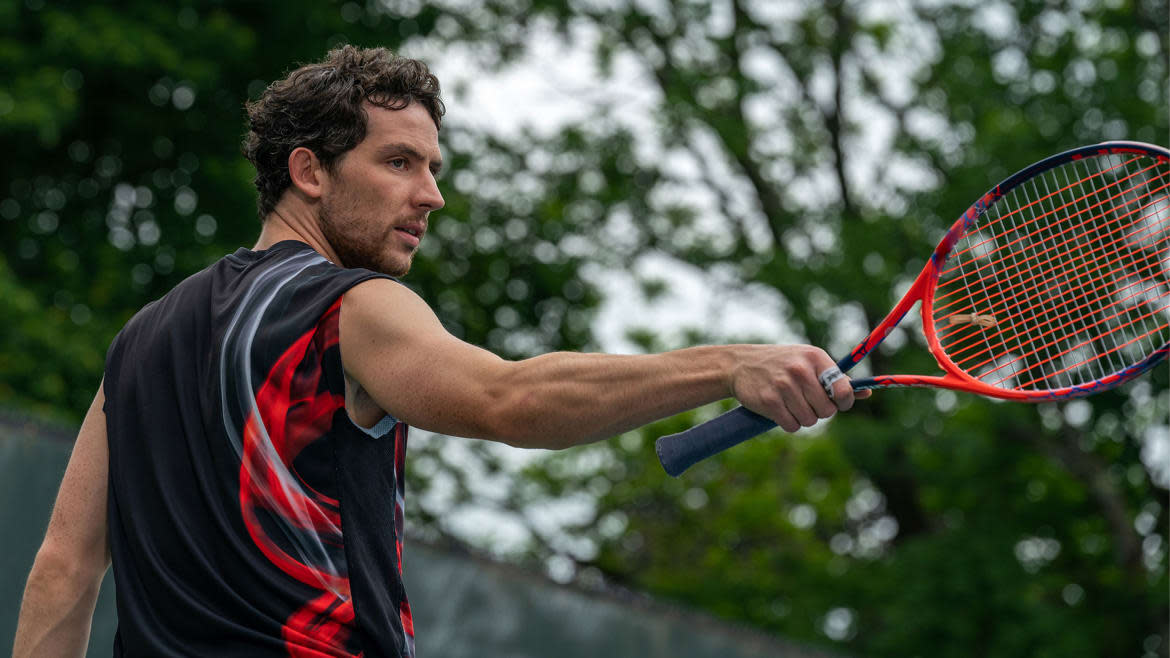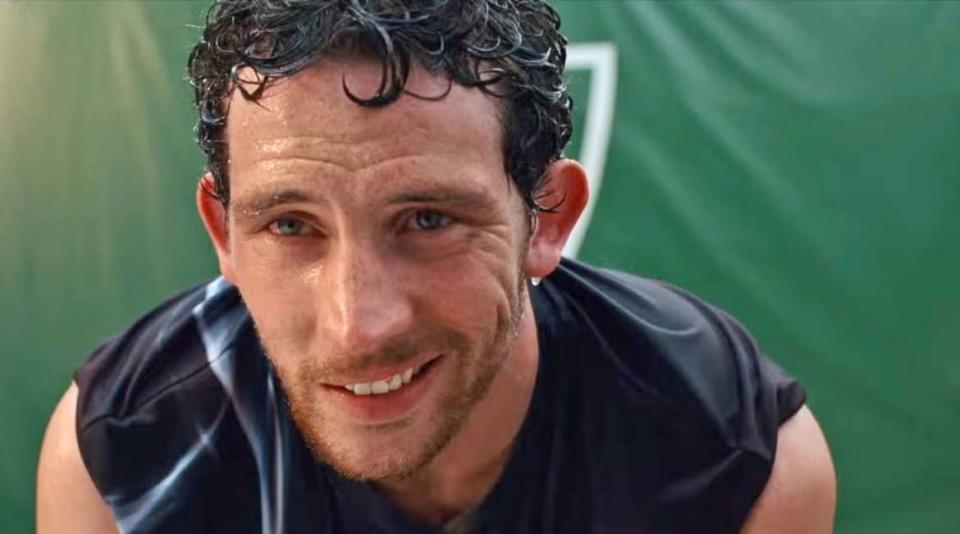How That Epic (and Sexy) ‘Challengers’ Final Tennis Match Was Made

Two hours of foreplay has led up to this moment.
The last scene in writer Justin Kuritzkes and director Luca Guadagnino’s horny tennis film Challengers isn’t so much about who actually wins the tournament final between Josh O'Connor’s down-and-out Patrick Zweig and Mike Faist’s all-star Art Donaldson. Nor is it really necessarily a competition to see who has “won” the heart of Art’s wife and coach, Tashi Duncan (Zendaya).
No, this match is about everything that’s unsaid between the members of this ultra-competitive love triangle. In fact, with all the grunts, whacks, squealing shoes, and perspiration, there’s little dialogue in it all.
“Tennis sounds are usually relaxing sounds, but we decided to push the tennis sound to the extreme,” Marco Costa, the film’s editor, says of the directive he received from Guadagnino. “Especially in the last sequence because they are getting so louder until the final moment when they finally hug each other, because we wanted the audience to be so close to the racquet, to the shoes of the players.”
In the end, he says the scene was both the most difficult one to capture, and the one that took him the longest in the editing room, but it was also the most fun.
This Explosive ‘Challengers’ Debate Is Tearing the World Apart
But, after all this tension, how do you show a climactic event? C’mon with us as Costa, as well as the film’s supervising sound editor Craig Berkey and sound designer Paul Carter, talk about the art of being perfectly good at being bad.
Game.
Costa says that Guadagnino storyboarded every tennis match, which meant the editor had an idea of what he was looking for when he was given the raw footage. He says that “the only risk was to lose the passion” for what’s happening on and off the court.
Berkey and Carter agreed, with Carter noting that Guadagnino “had a total vision right from the start and didn’t really change his mind in our process.”
“His aesthetic is not a North American film aesthetic,” says Berkey, who is originally from British Columbia. “I had to get there through experimentation. Paul and I would send them things and we would get notes [like] ‘We don’t want the Canadian version of that. We want the Italian version of it.’”
Costa adds that Guadagnino filmed the footage with a decades-old camera that he’d had to hunt down in Italy because the scene was all recorded in slow motion and on film.
Costa and Guadagnino wanted to look for specific angles that would form shapes, as well as shots that would send the camera ping-ponging from one of the three leads to another, to reference the central love triangle in the story.
“The tennis court is like a mirror,” Costa says of the scene that was first edited without sound. “The way Luca choreographed the scene, it’s like a dance where you can see these body moves around the tennis courts.”
It was also a test of restraint for the sound department.
“As audio people, we want to put a lot of sounds in there,” says Berkey. In this case, he says they did the opposite and “instead of having crowd sounds distracting or having the audience trying to figure out what's going on, we left room to focus on what's actually happening with the actors.”
Berkey says they also had to think about other things, like how Art’s (probably) more expensive shoes could make a different kind of squeaking noise on the court than Patrick’s.

Josh O'Connor
Set.
For the sound department, the challenge was figuring out what they could pick up naturally on the days the scene was filmed and what they’d have to add in later.
Berkey notes that “if you watch a tennis match on TV, you can see microphones at the ends of the court,” so they knew it wouldn’t look artificial to have microphones visible on their sets.
But he also says that sound mixer Lisa Piñero was also able to get “great tennis ‘hit’ sounds [like of balls hitting racquets] that had a great slap echo on them.”
“That is really hard to replicate when you’re going in and close-micing something or doing it in a different room or different studio,” Berkey says.
Carter says the team built a library of sounds recorded on location that had a “nice, realistic reverb.”
The ‘Challengers’ Boys Are Making Everyone Horny for Big Ears
“We could mix that with our sound effects that were dryer or closer recordings and choose whether we wanted them really close or farther away according to the shots on screen,” Carter adds.
Match.
But there was no way they could clearly catch every noise they needed.
Berkey says both O’Connor and Faist were brought in during post-production for automated dialogue replacement (or ADR) work. There, they were able to watch the footage and understand what was happening to their characters at each specific sequence. Dialogue editor Davide Favargiotti also added in breathing sounds during post-production.
To further complicate things, Costa notes that sometimes the actors weren’t actually using racquets during film days, for fear they’d fly out of their hands and break the camera. He adds that even though Faist, in particular, is actually a good tennis player, a lot of the neon yellow tennis balls that audiences saw hurtled at the screen (or that were sometimes given their own points of view) were also added in later with CGI thanks to the work of visual effects supervisor Brian Drewes and his Boston-based company, Zero VFX.
Costa also had to adjust the footage speed throughout the scene, which also impacted the sound department’s jobs.
Screw the Threesome: Churros Star in the Sexiest ‘Challengers’ Scene
“In those slo-mo shots you can see a character’s expression completely change and then you go ‘Ah, I think he’s deciding what he’s going to do now,’” Berkey says. “Our role was to make that the only thing that people are looking at.”
Part of this is a natural occurrence of the sport itself, Costa says, noting that a true tennis match “is made of slow moments and fast moments,” But, he says, the directive he received from Guadagnino was that “this scene has to be a symphony with editing, sound, and score.”
“Luca told me so many times that ‘I want to do a rave party on the tennis courts,’” Costa recalls, adding that the director told him “I wanted people to dance in the theater with us, with our characters.”
Get the Daily Beast's biggest scoops and scandals delivered right to your inbox. Sign up now.
Stay informed and gain unlimited access to the Daily Beast's unmatched reporting. Subscribe now.


